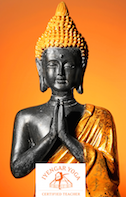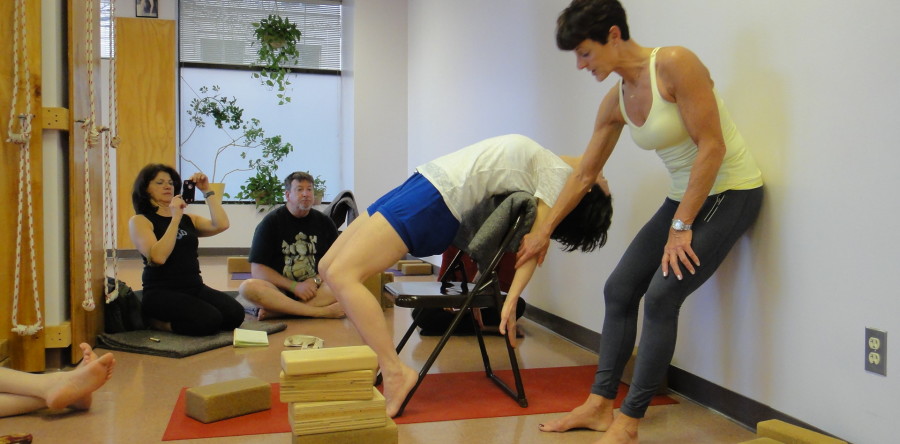Spotlight on Juliana Fair
By LC Roque
Juliana Fair began practicing yoga in 1974, discovered the Iyengar method in 1981, and began the certification process in 1986. Today she holds an Intermediate Senior I Certificate, which means that she is classified among approximately the top 55 Iyengar teachers in the United States.
For more than a quarter century, since 1990, Juliana has traveled annually to Pune, India, to study at RIMYI with the Iyengar family. A native of Australia, Juliana has taught in Australia and in Singapore, including instructing elite athletes in the Institutes of Sport.
Using a straightforward and humorous teaching style, Juliana supports students to progress with safety, as they address special issues and strengths of their own bodies. She builds her students’ confidence, and at the same time encourages them to learn about their potential and go beyond their perceived limitations.
What do you love most about teaching?
Seeing students become acquainted with their bodies and evolving their own practice. They often walk in injured and lacking confidence about what they’ll be able to do. I love to see them improve any injuries and progress, build physical strength, have new confidence in themselves, and experience joy when they are able to do asanas. It’s very rewarding.
What do you love most about practicing?
I love the mental space, the quiet meditative state, moving emotionally and physically to a different space. I also love being able to constantly improve in a pose, even though I’m aging, as we all are, and the insight into our own functioning, not just physical, but also psychological. And often my moments of clarity about how to treat a student or what to give a student to do, come as I practice. I’m not thinking about it but it just comes to me. It’s a wonderful space to be in--apart from the obvious health benefits.
When did you start practicing?
I was in my early 20s when a friend of mine invited me to join a yoga class, but it was not Iyengar. Four years later, I was moving from the Central Coast down to Sydney, and the teacher suggested an Iyengar school in Bondi Junction. She said, “The teacher’s a little bombastic, but you might like it.” So I started practicing the Iyengar method in 1981. I ventured in, it was all very casual, the timetable is right there, come along. First class was with Diane Curry. It was eye opening, mind blowing, finding your nirvana. I’d arrived. Mind you, it was terribly humbling. I was a runner. The teacher said, “Your legs don’t work,” and I thought either she was mad or she couldn’t see. But it never ended. I’m still finding parts that don’t work. I started out with one class a week. Then two. Then three. Then every day. For 10 years,1981 to 1990, all I did was yoga.
When did you start teaching?
In 1983, Guruji came to Australia and my teacher said, “You should come along.” I said, “You’re going, why should I go? I’m going to the beach.” She said, “No, come along, you’ll like it.” And of course I did. Everything about yoga was all wrapped up in one man: Guruji.
From 1984 on, my teacher Kay Parry was in Pune one or two times each year. After a couple of years of my assisting her, Kay said, “I’m going to Pune, I want you to teach some of my classes.” I said “no” the first year. The next year she said, “These are the classes you’re teaching.” I tentatively went into the room and stood at the front. There were still people left in the class when she came back, and Kay said, “You must be able to teach. There’s usually no one left in the class!”
The Australian Iyengar Association was formed in 1986 and Kay said, “You come along,” so I did. A short time later Kay said,”They are going to have apprentices so get on board.” I said ‘no.’ She said, “The spots are running out.” I said ‘no.’ She said, “There is 1 spot left!” I said to myself, “Alright I’ll take it just to keep her quiet!”
In 1987 Kay said, “You should sit for certification.” I said, “I don’t want to be a teacher, but I’ll sit for assessment if it keeps you quiet.” I passed the assessment. Then I started teaching, and retained people.
In 1990, I moved up north to Queensland, which is a resort area, with folks more interested in surfing than yoga, but I got quite a nice little class going for four years.
Then I moved to Singapore and got a couple of locations going, 20-23 people per class. My students were mostly Chinese, and they were quite concerned about it being a religion. That was a first, so I went home and did my homework.
I moved back to Australia and taught for 18 months, then moved to the United States with the intention of staying for 12 months. I’ve been here ever since!
I was never sure if I could make a living of it, but I’ve managed. I’m lucky that I can make a living at it. Much of my teaching is in-home privates. That started when I was playing in the gym and someone came up to me and said, “What is that? I want to do that!” I started teaching her in privates. Then, some of my group class students wanted to improve aspects and came for privates. Then people started telling others! Most of my privates are word of mouth. I get two general types of private students: people who don’t have days that end at 5 p.m., and people who have conditions that require more attention.
What do you most appreciate about students?
Them coming to class and being interested in what I have to teach, because there are many classes now. They’re very appreciative of what I have to offer, and they absorb what I’m saying. They are consistent, dedicated, and appreciate the holistic aspects of yoga. I’m appreciative of them being students. I learn a lot from them.
And I love that students come with good questions. Americans love questions. Keeps me on my toes! Can’t be spouting something you’ve read and don’t know. They’re listening.
What do you most appreciate about teachers-in-training?
My hat goes off to them, because today it is a grueling path, and they come with such passion and unwavering dedication. To get to the point of a Certified Iyengar Yoga Teacher, they are doing more than 80% of the teachers out there. They deserve my undivided attention. Also, there is a new crew coming through. That’s really important. They bring new energy to the method.
What advice do you have for students?
Practice. To get the real benefits of yoga, practice, however small an amount or insignificant you think it is.
It doesn’t have to be on the mat or a certain space, though it’s preferable, but it doesn’t need to be. Through practice you learn how good you feel when you practice, which makes you want to practice more.
Include the restorative asanas in your repertoire—once a month or more, so you learn how to efficiently set up the props and so you can see how you feel. Otherwise, under stressful circumstances, you’re less likely to do them. Being able to do restoratives with ease means you do them when you’re unwell, and reap the healing benefts. Under stressful conditions, like anxiety, or loss of family, job, or pet, you are able to help yourself. I like teaching restoratives because people are empowered and learn they can help themselves.
What advice do you have for teachers (in-training)?
If you’re teaching beginners, keep it as simple as you can. Teach what you know. Know what you teach. Even if you can only teach 10 asanas, know them inside out, the variations, and who needs what.
Make sure you’ve read the ethical guidelines in the book. Come with compassion and the desire to help people, have passion for the subject and the Iyengar method, and teach from the heart. People can tell if it’s not coming from the right place. You can learn how to teach aspects of the poses, but you must come with compassion, from the heart, otherwise it’ll wear you out.
Be careful not to injure yourself, either in adjusting or overdoing. You are an example. Take care of yourself.
Be humble, because your students teach you so much. Just because you come as the teacher to the class doesn’t mean you know everything. Listen to what your students are saying.






